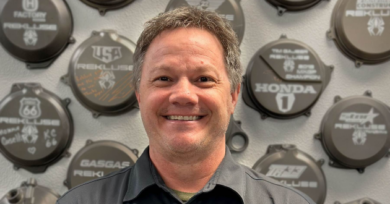May 14, 2007 – Nontraditional material enters the snow market
By Lynn Keillor
Snow editor
When customers first look at the new ZX2 composite rear suspension by AD Boivin Design Inc., they usually have two questions: Is it strong and what does it weigh?
Jeff Couture, tech support at the Levis, Quebec-based company, answers their questions with another question.
“I ask them if they would go back to a steel ski after being on a composite ski for the past 10 years,” he said. “They laugh, and their worries go away.”
AD Boivin, which also makes the Expert suspension and the Snow Hawk snow machine, introduced the ZX2 suspension in mid-April. The suspension’s radical look and nontraditional material have caught the eye and piqued the curiosity of many.
What Is It?
The ZX2 suspension is a proprietary AD Boivin design. It’s made primarily of composite plastic material with two side-by-side shocks in the rear of the suspension. There are two swing arms, 12 idler wheels and a short limiter strap in the front.
The ZX2 suspension has three unique components: the material, the G-Force shocks and the Revolver System of adjustment.
The composite material comes from the PPD Group in Sherbrooke, Quebec. “It’s not a joint venture [with PPD], but it’s a development joint venture” said AD Boivin’s owner, Denis Boivin. “They had the material, and we had the design and patents.”
The rails are made from a “secret recipe” composite from PPD. “We don’t know what’s in it, we just know it’s really strong,” Couture said. The remainder of the suspension is made from the same UHMW plastic found in skis.
Couture said the composite has some inherent advantages. “The good thing about the composite is it acts like a damper. It absorbs energy and vibration,” he said.
Another advantage, he says, is that snow won’t build up on the composite.
“There might be snow on it, but nothing compared to a regular suspension,” Couture said. “There’s a reason why those arms are designed that way, and it’s to prevent snow from getting into the suspension.”
Overall, the ZX2 weighs between 52-53 pounds. “People think it looks big and heavy, but it’s light,” Couture said. Depending on the suspension it’s replacing, it can be as much as a 30-pound difference.
Two G-Force shocks sit side-by-side in the rear of the suspension. The shocks are mainly Kayaba parts, but are patented by AD Boivin.
“They’re the heart of the suspension,” Couture said. The first 75 percent of the piston stroke works in the small to medium bumps. The upper 25 percent of the stroke hits different valving, tuned for big bumps, Couture says.
“The main problem with a suspension is that when it’s set to have smooth performance, it will bottom out in the big bumps,” he said. “The G-Force shock will kick in on the big g-bumps and prevent you from bottoming.”
Ease Of Operation
Couture says an effort was made to develop a user-friendly, simple-operating suspension.
For comparison, AD Boivin’s Expert suspension has 152 parts. There are 51 parts on the ZX2. Of those 51 parts, 12 are identical bolts.
Components are all standard, readily available sizes and mounting kits are designed with simplicity in mind.
“We’re hoping to cut a four- or five-hour job to an hour, hour-and-a-half,” he said.
The suspension adjustment features, called the Revolver System, is also modeled on ease, he says. The plate at the rear of the suspension has five holes and two pins. Two of the holes are for a weight transfer adjustment; the other three are for coupling.
Another unique feature is that there’s no extra oil or grease necessary since the UHMW itself has enough lubrication.
Sales Strategy
After the ZX2 introduction on April 16, the product has been available for sale directly from AD Boivin.
A special promotion, which expires May 31, puts a $899 U.S./$999 CND price tag on one unit. After the promotion expires, they will sell for $1,199 U.S./$1,299 CND. Mounting kits will sell for $99 U.S./$149 CND. There will be mounting kits for 26 different snowmobiles.
“The reaction has been really good,” Couture said, and the company has even sold a few. But customers, he adds, tend to want to look and touch the suspension in person.
While the suspensions are factory-direct now, he plans to sell the units through Expert X and Snow Hawk dealers.
AD Boivin will continue to sell direct, but it’s expected to be a small portion of the sales. Customers, he notes, prefer to deal with a live person when making these types of purchases.
In retrospect, Couture admits the company should have had more demo units available this past winter. It had two or three test units in Canada, and none in the U.S.
“People want to hear from those who try it,” he said. “Even if I tell them that it’s good and solid, they want to hear it from someone else, not the factory.”
He sent prototype units to the early buyers, just to get the feedback.
In The Beginning
In 1998, Denis Boivin, a mechanical engineer, came up with the idea of a plastic suspension.
He suggested it to his brother and business partner, Alain, who agreed with the novel approach.
Denis then built several prototypes and tested the concept for two years.
“In the beginning, we started with plastic to see if we could save weight,” Boivin said, adding that low cost was the second goal.
He experimented with nylon, which was stiff but not tough, and with UHMW, which was tough, but not stiff. The first prototypes were machined — not the molded product that the ZX2 has become.
“The new technology composite was not there,” Boivin said. In the end, the project was abandoned, but not forgotten. Boivin patented the idea.
By 2005, plastics technology had caught up to Boivin’s concepts and prototypes continued.
“I’m so satisfied with the product,” Boivin said of the final result. “It will be a revolution in snowmobile suspensions.”
Boivin said he was looking for particular advantages that plastic could offer over the standard aluminum suspension frame.
Welds, he says, can fail, especially in extreme low temperatures. Fatigue can stress and crack the rails.
“With UHMW composite, there is no more problems like this,” he said. “As you can see with the ski, it’s a good toughness, up to minus 70 degrees Celsius, and it will still stay flexible. There’s no welding, no heat treatment. It’s an integral material.”
Boivin says the suspension is tough, but stops short of calling it the “Titanic” of snowmobile suspensions.
“We’ve never had any failed or broken parts up until now,” he said, noting it was tested under severe conditions.
“I don’t want to say that it’s indestructible because then we’ll have customers trying to destroy it. But let’s just say that it’s tough — tougher than metals.”
This isn’t the only industry that uses these types of composite materials. Couture says that Formula One cars use composites in the motor connecting rods, and that it’s common in the aerospace industry.
Boivin is a bit coy as to the potential of composite products in other snowmobile applications.
“I think that there are other parts of the snowmobile where this product can be used,” he said, “but for now we will put our time into promoting our new suspension.”








